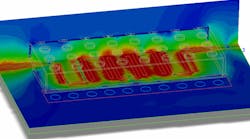Space Mapping Outpaces EM Optimization In Handset-Antenna Design
When it comes to handset antenna design, using full-wave electromagnetic (EM) simulators can be difficult because of high-performance requirements and space limitations. Such simulations may have to include some of the handset’s other components, which can lead to very lengthy EM simulations that are prohibitive in terms of optimization. Space mapping, which establishes mapping between a fine model of the considered device and a suitable coarse/surrogate model, can ease this process. A handset-antenna modeling and design technique that relies on space mapping has been presented by Sheng Tu, Yifan Zhang, Natalia K. Nikolova, Qingsha S. Cheng, and John W. Bandler from Ontario’s McMaster University.
With space mapping, the fine model is generally accurate but intensive in terms of the central-processing-unit (CPU) burden. The coarse model, in contrast, is much faster but less accurate. The surrogate model is the mapped coarse model, which better matches the fine model. In antenna design, a circuit-based coarse model is hard to come by because of the complexity of the structures. An alternative approach is to use wire models that imitate the geometry of complex handset antennas, but they may be prone to spurious resonances. In addition, wire modeling has been considered for preliminary estimation, but not in the framework of optimization.
In the work at McMaster University, thin-wire models have been exploited as coarse models in the space-mapping algorithms. The fine models, in turn, are high-accuracy EM simulations. Although the thin-wire models capture the basic physics of handset antennas, they do not have the accuracy of the fine model. However, they are computationally cheap when analyzed by Method-of-Moments (MoM) solvers. The team employs two space-mapping algorithms: implicit, input, and output space mapping versus implicit and output space mapping. The researchers succeeded in designing an internal, dual-band patch antenna as well as an arm-folded planar inverted-F antenna. See “Space Mapping Optimization of Handset Antennas Exploiting Thin-Wire Models,” IEEE Transactions On Antennas And Propagation, July 2013, p. 3797.

